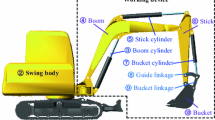Abstract
The workspace, working velocity, excavating force, and load capacity of a hydraulic excavator play critical roles in the performance of the excavator for various tasks. This paper presents an optimal design of the front linkage of an excavator to maximize the performances of several indices simultaneously. A multi-objective function is defined to increase the excavator’s workspace, working velocity, excavating force, and load capacity simultaneously. The workspace is defined by using four geometrical indices and the working velocity is defined by the amount of time needed to perform one cycle composed of digging and dumping. The excavating force consists of two forces, and the load capacity is defined by using the minimum values of three types with specific operations. A total of 10 indices define objective function with each weight, and pin-points of the front linkage are the design parameters, including joint positions of links and hydraulic actuators. A two-step optimization procedure is considered based on a new method called the hybrid Taguchi-random coordinate search algorithm. The results indicate a 3.43% increase in performance relative to the initial design parameters of a commercial excavator. More specifically, the excavator’s workspace, working velocity, excavating force, and load capacity increase by 5.55%, 0.14%, 5.46%, and 0.33%, respectively. These improved design parameters can be applied to next generation excavators.
Similar content being viewed by others

References
O. K. Lim and H. Cho, Optimal shape design of excavator boom using the semi-analytical method, Journal of KSME, 19 (1) 301–309 (1995).
P. K. Vähä and M. J. Skibniewski, Dynamic model of excavator, Journal of aerospace engineering, 6 (2) 148–158 (1993).
A. J. Koivo, M. Thoma, E. Kocaoglan and J. Andrade-Cetto, Modeling and control of excavator dynamics during digging operation, Journal of Aerospace Engineering, 9 (1) 10–18 (1996).
G. Wszolek, Vibration analysis of the excavator model in GRAFSIM program on the basis of a block diagram method, Journal of Materials Processing Technology, 157 (2004) 268–273.
F. G. Flores, A. Kecskeméthy and A. Pöttker, Workspace analysis and maximal force calculation of a face-shovel excavator using kinematical transformers, In Proceedings of the 12th IFToMM World Congress, Besancon, France (2007) 375–381.
K. Shin, S. Lee, H. Shin, Y. Yoo and J. Kim, Coupled linkage system optimization for minimum power consumption, Journal of Mechanical Science and Technology, 26 (4) (2012) 1099–1106.
SAE, http://www.sae.org/ (retrieved at 04/03/13).
ISO, http://www.iso.org/iso/home.html (retrieved at 04/03/ 13).
D. R. Jones, M. Schonlau and W. J. Welch, Efficient global optimization of expensive black-box functions, Journal of Global optimization, 13 (4) (1998) 455–492.
L. M. Rios and N. V. Sahinidis, Derivative-free optimization: A review of algorithms and comparison of software implementations, Journal of Global Optimization (2011) 1–47.
J. W. Kim, S. Jung, J. Kim and T. W. Seo, A hybrid taguchi-random coordinate search algorithm for global numerical optimization problem, International Journal for Numerical Methods in Engineering (2013).
G. S. Peace, Taguchi methods: a hands-on approach, Wokingham, England: Addison-Wesley (1993) 23–311.
S. K. Acharyya and M. Mandal, Performance of EAs for four-bar linkage synthesis, Mechanism and Machine Theory, 44 (9) (2009) 1784–1794.
Author information
Authors and Affiliations
Corresponding authors
Additional information
Recommended by Associate Editor Gang-Won Jang
Jong-Won Kim is a Ph.D. Candidate in the School of Mechanical and Aerospace Engineering, Seoul National University, Korea where he also received B.S. degree in 2012. His research interests include optimization, robotics and creative design.
Seungmin Jung is a master’s degree candidate in the School of Mechanical and Aerospace Engineering at Seoul National University, Korea. She received her B.S degree in mechatronics engineering from Korea University of Technology and Education, Korea in 2012. Her research interests include creative robotic design, robotics and robotic prosthesis.
Jiunk Kim is with Doosan Infracore Co. He is a researcher in excavator development team. He received M.S. in Mechanical Engineering, Yonsei University. His research interests include design based on knowledge information.
Jongwon Kim is a Professor in the School of Mechanical and Aerospace Engineering, Seoul National University, Korea. He received the B.S. degree in Mechanical Engineering from Seoul National University in 1978, and the M.S. degree in Mechanical and Aerospace Engineering from KAIST, Korea, in 1980. He received the Ph.D. in Mechanical Engineering from the University of Wisconsin-Madison, USA, in 1987. He worked with Daewoo Heavy Industry & Machinery, Korea, from 1980 to 1984. From 1987 to 1989, he was Director of the Central R&D Division at Daewoo Heavy Industry & Machinery. From 1989 to 1993, he was a Researcher at the Automation and Systems Research Institute at Seoul National University. His research interests include parallel mechanisms, Taguchi methodology, and field robots.
TaeWon Seo is an Assistant Professor in the School of Mechanical Engineering, Yeung-nam University, Gyeongsan, Korea. He received the Ph.D. degree in Mechanical Engineering, Seoul National University, in 2008. He was a Post-Doctoral Researcher at the Nanorobotics Laboratory, Carnegie Mellon University, in 2009. His research interests include creative robotic platform design, control, optimization, and motion planning.
Rights and permissions
About this article
Cite this article
Kim, JW., Jung, S., Kim, J. et al. Optimal design of the front linkage of a hydraulic excavator for multi-objective function. J Mech Sci Technol 28, 3103–3111 (2014). https://doi.org/10.1007/s12206-014-0718-x
Received:
Revised:
Accepted:
Published:
Issue Date:
DOI: https://doi.org/10.1007/s12206-014-0718-x



